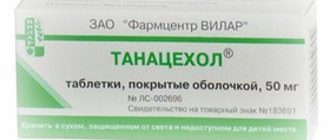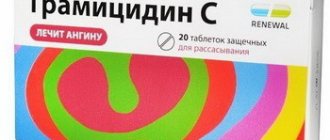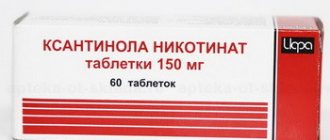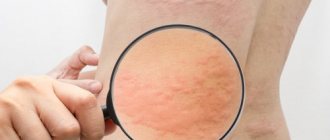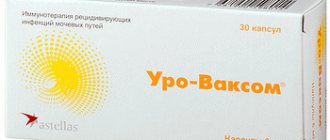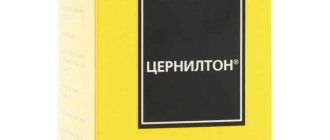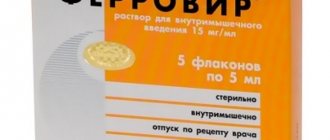(No ratings yet!)
Fexadin is a medicine intended to treat various manifestations of an allergic reaction. The main component of this drug is fexofenadine. In this article we will look at the instructions for using Fexadin, its cost and analogues in composition and action, and also provide reviews from allergy sufferers and doctors.
Third generation antihistamine. It is not a hormonal drug and is not an antibiotic.
Fexadine is an Indian-made generic of the drug Telfast (Allegra).
Trade name: Fexadin®
Latin name: Fexadin®
Manufacturer: Ranbaxy (India)
Official website of the drug: fexadin.ru
After using Fexadin, the first symptoms disappear within an hour. After 2-3 hours, the effect of the drug reaches its maximum and lasts for 12 hours.
Release form and composition
Fexadin is available in the form of film-coated tablets: oval, biconvex, pink, with the inscription in black ink on one side “FXD 120” or “FXD 180” (10 pieces each in strip packs, one or two packs in a cardboard pack) .
Composition of 1 tablet:
- active ingredient: fexofenadine hydrochloride – 120 mg or 180 mg;
- auxiliary components: pregelatinized starch, colloidal silicon dioxide, croscarmellose sodium, magnesium stearate, microcrystalline cellulose, povidone, purified water;
- film shell: Opadry pink OY-54957 (macrogol 400, hypromellose, red iron oxide dye, titanium dioxide, purified water);
- printing ink: N-butanol, shellac, propylene glycol, black iron oxide dye, isopropanol, purified water, methylated alcohol 74 OR.
Fexadin price
The price of the drug depends on the region of residence and the form of release.
| Release form | Price |
| Tablets 120 mg (10 pcs) | 280 rub. |
| Tablets 180 mg (10 pcs) | 380 rub. |
Prices can vary around 50-100 rubles.
For comparison, the cost of some analogs of Fexadine (based on fexofenadine), including cheap ones:
| Analogue | 120 mg, 10 pcs | 180 mg, 10 pcs |
| Fexofast, Micro Labs Ltd, India | 190 rub. | 260 rub. |
| Allegra, Sanofi-Aventis, France | 680 rub. | 980 rub. |
Pharmacological properties
Pharmacodynamics
Fexofenadine hydrochloride is a histamine H1 receptor blocker. It is practically devoid of sedative effects. It is a metabolite of terfenadine with pharmacological activity.
The antihistamine effect of the drug appears 1 hour after administration, and the maximum effect is achieved after 6 hours and continues throughout the day. After 4 weeks of using Fexadin, the development of tolerance is not observed. When taking doses from 10 mg to 130 mg, a linear dependence of the effect on the dose of the drug is observed. For allergic rhinitis, a dose of 120 mg is sufficient to achieve effectiveness for 24 hours. When used in doses up to 240 mg, no changes in the QT interval are observed.
Pharmacokinetics
After oral administration, fexofenadine hydrochloride is rapidly absorbed from the gastrointestinal tract. The time to reach Cmax (maximum concentration) is 1–3 hours. The average Cmax value after taking the drug at a dose of 120 mg is 289 ng/ml, at a dose of 180 mg – about 494 ng/ml. Fexofenadine is 60–70% bound to plasma proteins (mainly alpha1-glycoprotein and albumin). Does not penetrate the blood-brain barrier. About 5% of the dose taken is metabolized.
Fexofenadine elimination is biphasic. T1/2 (half-life) after repeated doses of the drug is 11–15 hours. In moderate and severe renal failure, the half-life increases by 59% and 72%, respectively (in patients on hemodialysis - by 31%). Pharmacokinetic parameters with single and multiple doses of Fexadin (up to 120 mg twice a day) change linearly.
Up to 80% of fexofenadine is excreted in the bile, about 10% is excreted unchanged in the urine.
Instructions for use of Fexadin
According to the instructions, Fexadin should be taken orally at a dose of 120 mg 1 time per day for the treatment of hay fever and rhinitis, and for idiopathic urticaria - 180 mg 1 time per day. The drug should not be prescribed to children under 6 years of age, and from 6 to 12 years of age the daily dosage should not exceed 60 mg.
The attending physician must determine the dosage of Fexadin in accordance with the formula - “indications - dose - effect”. If there is no therapeutic effect within 24 hours after administration, the drug should be discontinued. Patients with liver and kidney failure should take the drug 60 mg per day.
In accordance with the instructions, Fexadin may cause a decrease in psychomotor reactions. Patients driving vehicles and working in hazardous areas should exercise caution or limit their activities.
Before prescribing the drug, it is necessary to check the patient's individual response to its components.
special instructions
There are no data on the use of Fexadin in older patients and patients with impaired renal function, so the drug is prescribed to such patients with caution.
Impact on the ability to drive vehicles and complex mechanisms
Before performing work associated with high concentration and reaction speed (operating machinery, driving a car), it is necessary to determine the patient’s individual reaction to the drug. If Fexadin is well tolerated and does not cause side effects, the patient can perform this type of work without restrictions.
Similar drugs:
- Ergoferon () Lozenges
- Celandine grass (Chelidonii majoris herba) Vegetable raw materials
- L-cet Oral tablets
- Loratadine Syrup
- Peritol Oral tablets
- Loratadine-Teva Oral tablets
- Erespal Oral tablets
- Levocetirizine-Teva Oral tablets
- Aminazine Dragee
- Lordestin Oral tablets
** The Drug Directory is intended for informational purposes only. For more complete information, please refer to the manufacturer's instructions. Do not self-medicate; Before starting to use Fexadin, you should consult a doctor. EUROLAB is not responsible for the consequences caused by the use of information posted on the portal. Any information on the site does not replace medical advice and cannot serve as a guarantee of the positive effect of the drug.
Are you interested in the drug Fexadin? Do you want to know more detailed information or do you need a doctor's examination? Or do you need an inspection? You can make an appointment with a doctor - the Euro lab is always at your service! The best doctors will examine you, advise you, provide the necessary assistance and make a diagnosis. You can also call a doctor at home . Euro lab clinic is open for you around the clock.
** Attention! The information presented in this medication guide is intended for medical professionals and should not be used as a basis for self-medication. The description of the drug Fexadin is provided for informational purposes and is not intended for prescribing treatment without the participation of a doctor. Patients need to consult a specialist!
If you are interested in any other drugs and medications, their descriptions and instructions for use, information about the composition and form of release, indications for use and side effects, methods of use, prices and reviews of drugs, or you have any other questions and suggestions - write to us, we will definitely try to help you.
Drug interactions
With simultaneous use of Fexadine with ketoconazole or erythromycin, the plasma concentration of fexofenadine increases 2-3 times, which is apparently due to increased absorption from the gastrointestinal tract and a reduction in gastrointestinal secretion or excretion of bile. The QT interval does not change.
When taking antacids containing magnesium or aluminum 15 minutes before taking Fexadin, a decrease in its bioavailability was observed, therefore it is recommended to maintain a 2-hour interval between taking the drug and magnesium or aluminum containing antacids.
Fexofenadine does not interact with omeprazole and other drugs that are metabolized in the liver.
Fexadin's analogs
What can replace Fexadin? At the moment, there are not many drugs based on fexofenadine on the Russian market. You can freely find on sale:
- Allegra (Telfas) is the original drug,
- Fexofast.
The Russian analogue of Fexadin is Allerfex, but it is almost impossible to find on sale.
In addition, there are such analogues: Gifast, Allerfex, Fexofenadine, Beksist-Sanovel, Dinox, Rapido, Telfadin - they are more difficult to buy in Russia, but can be found abroad.
Commercial names abroad (abroad): Allegra, Allerfen, Allerfexo, Allerstat, Altiva, Dinox, Fexidine, Fexigra, Fexotrol, Fexova, Fastofen, Histaloc, Kalicet, Tilfur, Telfexo, Torfast, Vifas, Zafil.
Review: The drug is good, but it causes headaches
When choosing which is better - Fexadin or Fexofast, or Allegra, it is worth considering that the first two are generics of Allegra (Telfast), but in terms of effectiveness they are not much inferior to the original drug, and in price they are much cheaper.
In addition, the price affects the quality of the raw material and its purification - accordingly, the frequency of side effects.
Comparison of drugs
Below in the table you can see the comparative characteristics of popular antihistamines of different generations.
Pharmacodynamics and pharmacokinetics
The active substance is fexofenadine . The mechanism of action is aimed at blocking H1-histamine receptors. The main substance is the active metabolite of terfenadine . The drug stabilizes the mast cell , reduces the amount of histamine , biologically active components.
The antiallergic effect develops an hour after the drug Fexadin enters the body. The maximum antiallergic effect is recorded after 6 hours, the duration of the antiallergic effect is about a day.
When taking fexofenadine, the usual side effects of antihistamines do not develop: constipation , disturbances of the visual analyzer, dry mouth, cardiotoxic effects (changes in the QT interval on the cardiogram). Long-term use is not accompanied by weight gain.
Elderly people and patients with pathologies of the renal and hepatic systems do not require dose adjustment of the drug Fexadin.
The drug does not potentiate the effect of alcohol-containing drinks and medications that depress the nervous system.
A dose-dependent effect was noted when taking 10-130 mg.
Indications for use
for adults
Tablets at a dosage of 120 mg are prescribed for seasonal allergic rhinitis, which is accompanied by the following symptoms:
- sneezing;
- itching;
- rhinitis;
- redness of the mucous membrane of the eyes.
Fexadin in a dosage of 180 mg is prescribed for chronic idiopathic urticaria, to eliminate signs of the disease such as itching and redness of the skin.
for children
According to indications, Fexadin can be used in children over 12 years of age.
for pregnant women and during lactation
The antiallergic drug should not be prescribed to pregnant and lactating patients, since there is no experience in treating these categories of patients.
Side effects
If you take higher doses of the drug, the severity of side effects increases. Negative reactions of using Fexadin tablets include:
- fatigue, fatigue;
- dyspeptic disorders (nausea, vomiting, stomach pain, diarrhea, constipation);
- dysmenorrhea;
- hypersensitivity reactions (shortness of breath, angioedema, skin rash, urticaria, itching of the skin);
- insomnia, sleep disturbances, nervousness;
- dizziness, increased drowsiness, headache;
- pain in the heart, chest, tachycardia;
- photosensitivity (increased sensitivity of the skin to sunlight);
- anaphylactic reactions (swelling of the throat, difficulty breathing);
- disruption of taste buds.

